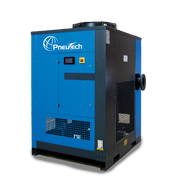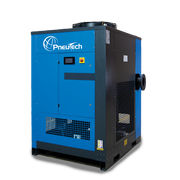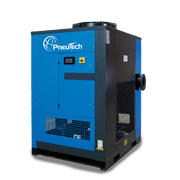

Air Dryers for Compressed Air Systems
Refrigerated or desiccant drying systems are the industry standard to ensure a consistent supply of dry air. We carry a range of dryers for compressed air systems to guarantee you the dew point you need for your applications.
About Our Air Dryers for Compressed Air Systems
Fluid-Aire Dynamics sells high-quality refrigerated and desiccant compressed air dryers from PneuTech and other national brands, including AirCel, Great Lakes Air and Ingersoll Rand.
- Refrigerated air dryers are the top seller for general industry, such as powering pneumatic tools. With dew points down to ~38°F, they are suitable for applications that require air with no visible moisture (ISO Quality Classes 4, 5 & 6).
- Desiccant air dryers are capable of lowering the dew point of compressed air to -40°F or even -100°F. They are a great choice for applications requiring extra-dry air (ISO Quality Classes 1, 2, & 3) and processes running below 38°F.
If you’re not sure which type of compressed air dryer is right for you, the specialists at Fluid-Aire Dynamics can help. We’ll help you evaluate your compressed air usage, dew point requirements, and potential energy savings to choose the right air dryer for your application.


Get in Touch Today
We are here to serve your compressed air system needs 24/7/365. Call or click today!
Contact usFAQ
Why do I need a compressed air dryer?
Air dryers are used to remove moisture from compressed air that can cause issues with the manufacturing processes, pneumatic equipment and in the compressed air network itself. Moisture is a natural byproduct of the compression process. Air coming into the compressor contains water vapor (humidity). As air is compressed, the pressure squeezes the water out of the air, turning it back into a liquid. Warmer air holds more water vapor than cooler air, so the hot air coming out of the compressor still holds some water vapor. As the pressurized air cools down, more of this vapor falls out of the air as condensation. Without an air dryer, you’ll end up with liquid water throughout your distribution system and even in the compressed air stream at the end point.
Water in your condensed air causes a number of problems, both for your compressed air system itself and for the processes and applications using the air. These problems may include:
- Corrosion in compressed air pipes or system components
- Damage to pneumatic tools
- Problems with finished materials, such as rusting, spoilage or poor finish quality.
Clean, dry compressed air is important for most applications. That’s why you need an air dryer. The air dryer removes most of the moisture that is left in compressed air after it leaves the compressor. An air dryer is an important component of a complete industrial compressed air system.
What is the difference between a refrigerated and a desiccant air dryer, and how do I know which one I need?
Both refrigerated and desiccant air dryers remove moisture from compressed air. But there are significant differences in how they do it, how much moisture they remove, and how much they cost to operate.
- Refrigerated air dryers remove moisture by cooling the air. Because cooler air can’t hold as much water as warmer air, moisture will condense back into a liquid form as the air cools. The liquid water is collected in a water trap and removed via a drain valve. There are two types of refrigerated air dryers: cycling and non-cycling. Non-cycling air dryers allow the refrigeration circuit to run continually, and cycling dryers reduce energy use by cycling on and off in response to demand. These dryers cost a bit more upfront but are much more energy-efficient over the long run.
- A desiccant air dryer removes water from the air using a process called adsorption. An adsorptive material (such as carbon molecular sieve or activated alumina) is packed into a desiccant bed. As air flows through the desiccant, water molecules are trapped in tiny micropores in the material. Once the material becomes saturated, it can be recharged and used again. Most desiccant air dryers have two towers so one tower can be used for drying while the other is being recharged.
Desiccant air dryers are more expensive than refrigerated air dryers, both in their initial capital investment and in operating and maintenance costs. Refrigerated air dryers tend to have lower capital investment and lower operating and maintenance costs, but yield higher dew points (more moisture left in the air).
How do you know which type of air dryer is right for you? It mainly comes down to three questions:
- What are the dew point requirements and ISO ratings for your application? Is ultra-dry air required? For most general industrial applications (ISO classes 4 and up), a refrigerated dryer is perfectly adequate. If you require ultra-dry air for your processes(ISO classes 1-3) you may need a desiccant dryer. A desiccant dryer is often needed for medical, food or pharmaceutical applications requiring high-purity, ultra-dry air.
- Will your application be operating below 38°F? Refrigerated air dryers do not operate well below this temperature. If your application runs in near-freezing or below-freezing conditions, you will need a desiccant air dryer.
- Will your air dryer be running more or less consistently during each shift, or does your demand vary? If your demand varies, you may benefit from a cycling air dryer that can ramp up and down with demand.
What is the dew point of compressed air?
Compressed air dryers are usually rated in terms of dew point. What does dew point mean in a compressed air system? It is a measure of how much moisture is in the air. Dew point is given in temperature (either °F or °C). The lower the dew point, the drier the air. The dew point rating is the temperature at which water vapor will condense out of the compressed air stream into liquid water.
This is the same process by which dew (or frost) forms on the grass overnight. Warmer air holds more moisture than cooler air. As air cools down overnight, excess moisture that the air can no longer hold falls out of the air as liquid dew (or condensation). The temperature at which you will see dew depends on how much water vapor the air is carrying (i.e., humidity level). If the air is very dry, it has to be much colder to form dew than if the air is already saturated with moisture. The dew point, or temperature at which dew forms, can therefore be used as a measure of humidity.
The exact same process works in your compressed air equipment. The dew point rating for your air dryer tells you how dry it is able to get the air. A refrigerated air compressor can get air down to a dew point of ~38°F, or just a little above freezing. That means if the temperature drops below 38°F at any point during your processes, you will see liquid water. A desiccant air dryer can get air much drier, down to a dew point of -40°F or even -100°F. In other words, there is so little water vapor in the air that it will not form condensate even at temperatures far below freezing. Understanding the dew point requirements for your compressed air will help you choose the right air dryer for your application.











